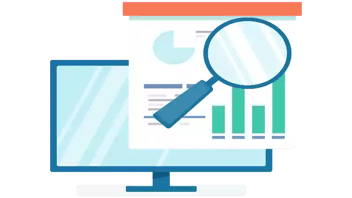Design for Conversion: Iterative Building for High-Performing Websites
What’s your strategy for developing a website that truly performs? Are you looking for a website that not only attracts visitors but also effectively guides them toward a specific action, whether it's making a purchase, signing up for a newsletter, or requesting a quote? The objective is clear: to create high-performing websites that consistently drive desired conversions. This isn't achieved through a one-time build, but rather through a dynamic, data-driven, and iterative approach to web design.
How does this methodology work in practice? It involves a process of continuous adaptation, where regular testing, optimization, and in-depth data analysis become the cornerstones of your website's evolution. This iterative design process is intrinsically linked to improving your online visibility and consistently attracting the right visitors.
The Evolving Landscape of Web Performance
Initial thoughts about web design often gravitate towards visual appeal, and for good reason—a beautiful website can certainly make a strong first impression. But what truly matters in modern web design goes far deeper than aesthetics. It's about functionality, user experience, and ultimately, conversion. Consider this: a visually stunning website that fails to convert visitors into customers is, by definition, underperforming.
Every element on your website should serve a purpose: to nudge the user towards a specific goal. This could be a purchase, a form submission, a download, or even a simple click to learn more. For example, e-commerce sites often aim for high conversion rates for product purchases, while B2B sites might prioritize lead generation through contact forms. So, how do you ensure your website meets these objectives and becomes one of those truly high-performing websites?
The answer lies in a continuous cycle of design, deployment, analysis, and refinement, all guided by data. This isn't a one-and-done project; it’s an ongoing commitment to excellence and adaptation. This commitment forms the core of an iterative approach to web design.
The Pillars of Iterative Web Design: A Methodical Process
We break down the iterative approach into several critical phases to achieve high-performing websites. This methodical process ensures every decision is backed by insights, leading to continuous optimization.
Phase 1: Deep-Dive Data Analysis and Research
Understanding your audience and their behavior is paramount. Where do they come from? What are their pain points? What are they looking for? This is where robust data analysis comes into play.
Start by leveraging existing website analytics. Are your bounce rates high? If your bounce rate is, say, over 50% for key landing pages, it might indicate a disconnect between user expectations and content. What about time on page? A low time on page (e.g., less than 30 seconds) on critical content could signal disinterest or difficulty in finding information. Furthermore, closely examine your conversion funnels. Identifying drop-off points in your conversion path is crucial. For instance, if 70% of users abandon their carts at the shipping information stage, that's a clear area for improvement that begs for optimization.
Don't overlook competitor analysis. What are industry leaders doing effectively on their websites? What are their websites optimized for? And finally, user feedback mechanisms like surveys, heatmaps, and user testing provide invaluable qualitative insights that complement quantitative data. For instance, a heatmap might reveal that users consistently click on non-clickable elements, indicating a design flaw that needs attention.
Phase 2: Hypothesis Generation and Design Formulation
Based on your data, what are your educated guesses about what will improve performance? This phase involves formulating clear hypotheses. For example, you might hypothesize: "If we simplify our checkout process by removing one step, we will see a 10% increase in conversion rates." This then guides your design formulation, focusing on optimization.
Designing for conversion is key here, rooted in strong user experience (UX) and user interface (UI) principles. This means prioritizing intuitive navigation, clear calls to action, and mobile responsiveness. Did you know that 85% of adults think that a company's mobile website should be as good or better than their desktop website? Your content strategy must also be aligned with user intent. Is your content answering the questions your audience is asking? And are your call-to-action (CTA) buttons optimized? Are they clear, compelling, and strategically placed? Studies show that personalized CTAs convert 202% better than basic CTAs.
Phase 3: Implementation and Rigorous A/B Testing
How do you validate your hypotheses and ensure your website is truly high-performing? Through systematic testing. This is where A/B testing (also known as split testing) becomes invaluable. It involves comparing two versions of a webpage or element to see which performs better. This could be anything from headline variations to button colors or even entire page layouts. Imagine testing two different headlines for a landing page and observing which one leads to more form submissions—this is direct, data-driven optimization in action.
For more complex scenarios, multivariate testing allows you to test multiple variables simultaneously to understand their combined impact. While more intricate, it can yield more profound insights into user behavior. Throughout this phase, you must measure key performance indicators (KPIs). Beyond just conversions, track metrics like click-through rates (CTR), time on page, and bounce rate for each test variation to get a holistic view of performance.
Phase 4: In-depth Data Analysis and Interpretation
Once tests are complete, the real work of understanding the results begins. This phase demands meticulous data analysis and interpretation. First, establish statistical significance to ensure your test results are not due to random chance. Don't jump to conclusions based on small sample sizes. Then, identify trends and patterns. What do the numbers tell you about user preferences and behavior on your website?
The ultimate goal of this data analysis is to derive actionable insights. This means translating raw data into concrete recommendations for future iterations. For instance, if a specific CTA consistently outperforms others, that insight informs your broader web design strategy and leads to further optimization.
Phase 5: Refinement and Repetition (The Iterative Loop)
This is where the "iterative" in the iterative approach truly comes to life. Once you're done optimizing your website, optimize it again.
The cycle continues:
- What did you learn from the last iteration, and how will you apply it to the next?
- Implement winning variations by integrating successful test results into the live website.
- Then, formulate new hypotheses based on new data and insights.
- Do it again.
The digital landscape is constantly shifting, and your website should evolve with it. This continuous pursuit of optimization is not a destination; it's a journey of ongoing improvement. Companies that prioritize user experience see 2x higher conversion rates.
Connecting Iterative Design to Online Visibility and User Acquisition
An iterative approach to web design doesn't just improve conversions and significantly impacts your online visibility and ability to attract and retain the right visitors.
Beyond Conversion: How Design Impacts Search Engine Optimization (SEO)
How does a focus on user experience influence your search rankings? Google's algorithms increasingly prioritize user experience signals, strengthening the connection between web design and SEO.
Consider Core Web Vitals, Google's metrics for real-world user experience, including loading speed, interactivity, and visual stability. A slow-loading website (e.g., over 2.5 seconds for Largest Contentful Paint) can negatively impact both user experience and search rankings. Improved engagement metrics—higher time on page, lower bounce rates, and more clicks—signal to search engines that your content is valuable and relevant. Furthermore, with most searches now happening on mobile devices, a responsive and fast mobile website is no longer optional due to mobile-first indexing. According to Statista, 63% of all U.S. organic searches on Google originated from mobile devices in 2023. An iterative approach naturally addresses these factors, making your website more appealing to both users and search engines, thereby boosting your online visibility.
Attracting and Retaining the Right Visitors
Through continuous testing and optimization, iterative design helps you refine your content to better meet user needs, leading to higher engagement and repeat visits. Clear user paths, a hallmark of an optimized website, make it easier for users to find what they want, reducing frustration and increasing satisfaction. Ultimately, a professional, high-performing website instills confidence in your brand. A study conducted by Stanford University revealed that 75% of website credibility comes from design, which is not at all surprising.
Overcoming Challenges in the Iterative Design Process
While the benefits are clear, adopting an iterative approach does come with its own set of considerations.
The Myth of the "Perfect" Website Launch
It's crucial to understand that a website is never truly "finished." Embracing continuous improvement as a core philosophy is vital. The goal isn't a flawless launch but a commitment to ongoing refinement.
Resource Allocation and Prioritization
How do you decide what to test and when? Focus on high-impact areas. Based on your data analysis, prioritize changes that are likely to yield the most significant results. The value of dedicated teams with expertise in data analysis, UX/UI, and front-end development cannot be overstated; they can significantly accelerate the process of building high-performing websites.
The Importance of Patience and Persistence
Optimization is a marathon, not a sprint. Small, incremental gains can lead to substantial improvements over time. The key is to remain patient and persistent and consistently rely on your data to guide your decisions. If it's helpful, we've generated a guide about the seven most common things that will indicate that your site requires an overhaul.
The Path to High-Performing Websites
Designing a high-performing website is an ongoing journey of data-driven refinement. It's about understanding your audience, testing your assumptions, and continuously optimizing for conversion. The undeniable advantages of a data-driven approach are clear: reduced guesswork, increased efficiency, and demonstrably better results. Every decision is informed by real user behavior, not just intuition.
Ready to transform your website into a powerful conversion engine? At Aspiration Marketing, we specialize in implementing this data-driven, iterative approach to web design. Our expertise in understanding user behavior, coupled with our commitment to continuous optimization, ensures your website looks great and delivers measurable business outcomes.
Let us help you build a website that truly performs, driving online visibility and converting visitors into loyal customers.
This content is also available in:
- German: Design für Konversion: Iterativer Aufbau für leistungsstarke Websites
- Spanish: Diseño para la conversión: Desarrollo iterativo de sitios web
- French: Conception pour la conversion : Créer des sites web performants
- Italian: Progettare per la conversione: Sviluppo iterativo di siti performanti
- Romanian: Proiectare pentru conversie:Construcție iterativă,site-uri performante
- Chinese: 转换设计:迭代构建高效网站

Joachim is a certified HubSpot trainer with over 13 years of experience in content marketing, strategy, website development, and SEO. He has implemented numerous large-scale, international growth marketing programs, including one with UiPath, which grew from a startup to a successful IPO on the NYSE. Joachim has special expertise in multilingual marketing and sales enablement projects, and he uses the latest AI technologies to help our clients.








Leave a Comment